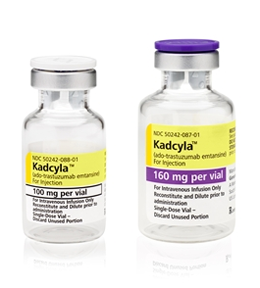AACR: T-DM1 Most Effective in Breast Cancer Patients With High HER2 Expression
Researchers participating in the phase III EMILIA trial have identified tumor biomarkers that can identify patients that are more likely to benefit from T-DM1. In the trial, women whose tumors had higher HER2 expression were most likely to benefit from the therapy.
Ado-trastuzumab emtansine (Kadcyla), known as T-DM1 during clinical research, is part of a new class of drugs called antibody-drug conjugates.

Washington, DC-In February 2013, the US Food and Drug Administration (FDA) approved a new type of therapy that combines the widely used HER2-targeted monoclonal antibody trastuzumab with the cytotoxic agent emtansine. The new drug, ado-trastuzumab emtansine (Kadcyla), known as T-DM1 during clinical research, is part of a new class of drugs called antibody-drug conjugates. T-DM1 directly binds tumor cells expressing HER2, delivering the attached cytotoxin specifically to tumor tissue and avoiding much of the toxicity to healthy tissue.
In the phase III EMILIA trial, T-DM1 extended overall survival of HER2-positive metastatic breast cancer patients who had been previously treated and progressed on trastuzumab combined with chemotherapy by 5.8 months from a median 25.1 months in the lapatinib plus capecitabine control arm to a median of 30.9 months in the T-DM1 experimental arm. Patients treated with T-DM1 also experienced less toxicity compared to those in the control arm.
Now, researchers participating in the trial have identified tumor biomarkers that can identify those women eligible for the treatment who are most likely to benefit from T-DM1. Women with higher HER2 tumor levels were more likely to benefit from the therapy.
The results are being presented by Jos Baselga, MD, PhD, physician-in-chief at the Memorial Sloan-Kettering Cancer Center in New York, at the American Association for Cancer Research (AACR) annual conference, held April 6–10 in Washington, DC.
The study authors used patient tissue samples collected during the EMILIA trial to analyze HER2 protein levels, HER2 mRNA levels, and PI3KCA mutation status.
The sub-analysis showed those patients whose tumor samples expressed greater than the overall median level of HER2 mRNA, considered to be high HER2 levels, derived greater benefit from T-DM1 compared to those who had low HER2 mRNA levels (median HER2 levels). Those women who had high HER2 levels had an overall survival of 34.1 months compared to 26.5 months for those women with low HER2 levels. Compared to those women expressing high HER2 levels, but treated with lapatinib and capecitabine in the control arm, those treated with T-DM1 had a 47% decreased risk for death.
“It had been suggested that since T-DM1 is an antibody-drug conjugate, that perhaps tumors with less HER2 expression might still be vulnerable to the cytotoxic effects of DM1, [the cytotoxin portion of T-DM1],” said Mark Pegram, MD, professor of oncology at the Stanford School of Medicine, director of the Breast Cancer Program at the Stanford Women’s Cancer Center, and one of the study authors. “However, our data from the EMILIA trial do not support this hypothesis.” The current findings are consistent with a retrospective analysis of a phase II T-DM1 clinical trial in which patients with lower levels of HER2 had shorter progression-free survival compared to patients with higher HER2 levels, Pegram added. “Future trials will continue to stipulate that evidence for high HER2 expression and/or HER2 gene amplification be used as selection criteria for T-DM1 treatment,” said Pegram.
The analysis also showed that PIK3CA mutation status of the tumor did not significantly affect the progression-free survival of those patients treated with T-DM1. HER2-positive breast cancer that also harbors a PIK3CA mutation does not respond as well to standard HER2-positive therapies such as trastuzumab when compared with HER2-positive PIK3CA wild type breast cancer, according to Baselga.
T-DM1 treatment outcomes were found to be neutral with respect to PIK3CA status, said Baselga in a press conference at the AACR meeting. Unlike a monoclonal antibody against HER2, T-DM1 also delivers the cytotoxin emtansine which is likely to facilitate inhibition of the PIK3CA tumor growth signals.
“Our data on PIK3CA mutation are very interesting since they suggest that DM1 may overcome relative resistance to HER2-targeted therapy associated with PIK3CA mutation,” said Pegram. “It will be important to evaluate this observation in patients with earlier stage disease in future adjuvant and neoadjuvant studies, as it may help to prioritize which patients are best treated with T-DM1 to circumvent such resistance mechanisms.”
This analysis supports the notion that HER2-positive breast cancers are not the same biologically and can respond differently to therapy depending on other underlying mutations and HER2 expression levels.
“The results are not practice changing at this point,” said Baselga in a press conference at the AACR meeting. Baselga noted that he recommends testing for the presence of a PIK3CA mutation in patients with HER2-positive breast cancer in order to better identify the right course of treatment. “If these EMILIA biomarker results are confirmed, an antibody-drug conjugate appears to be a good way to treat patients with HER2-positive disease and a PIK3CA mutation,” said Baselga.